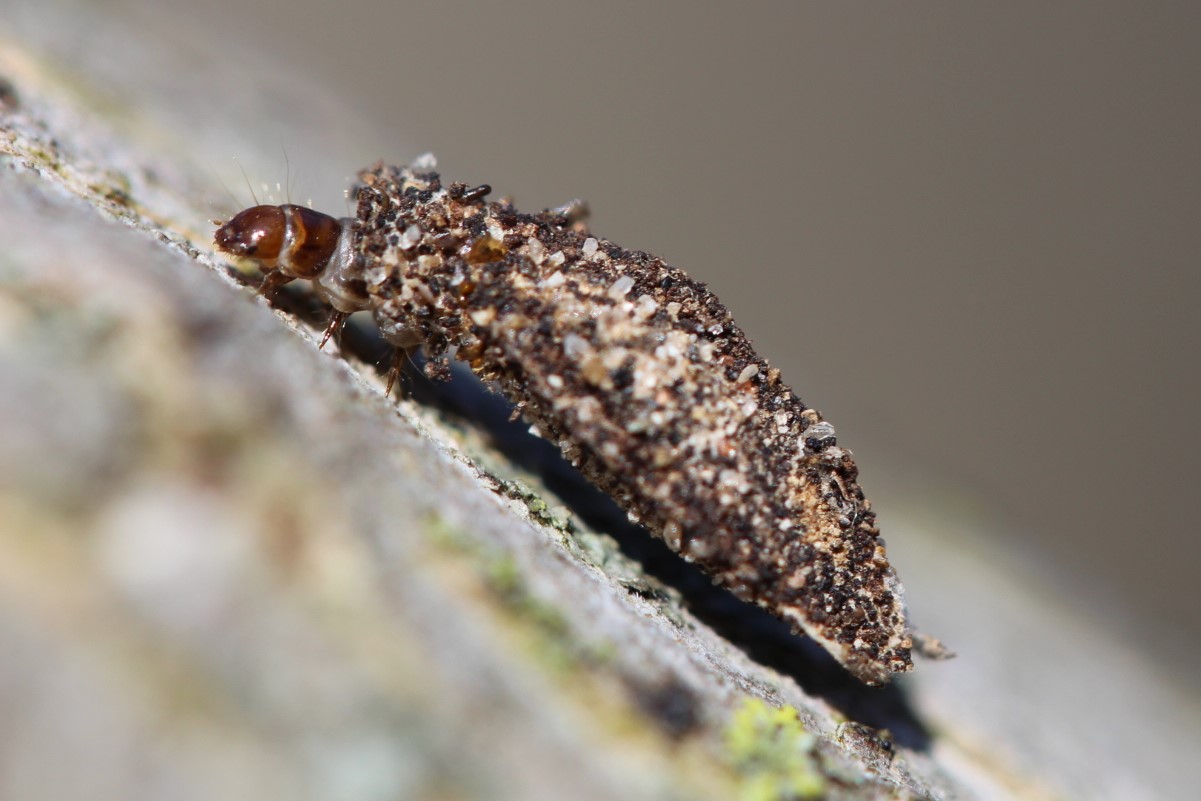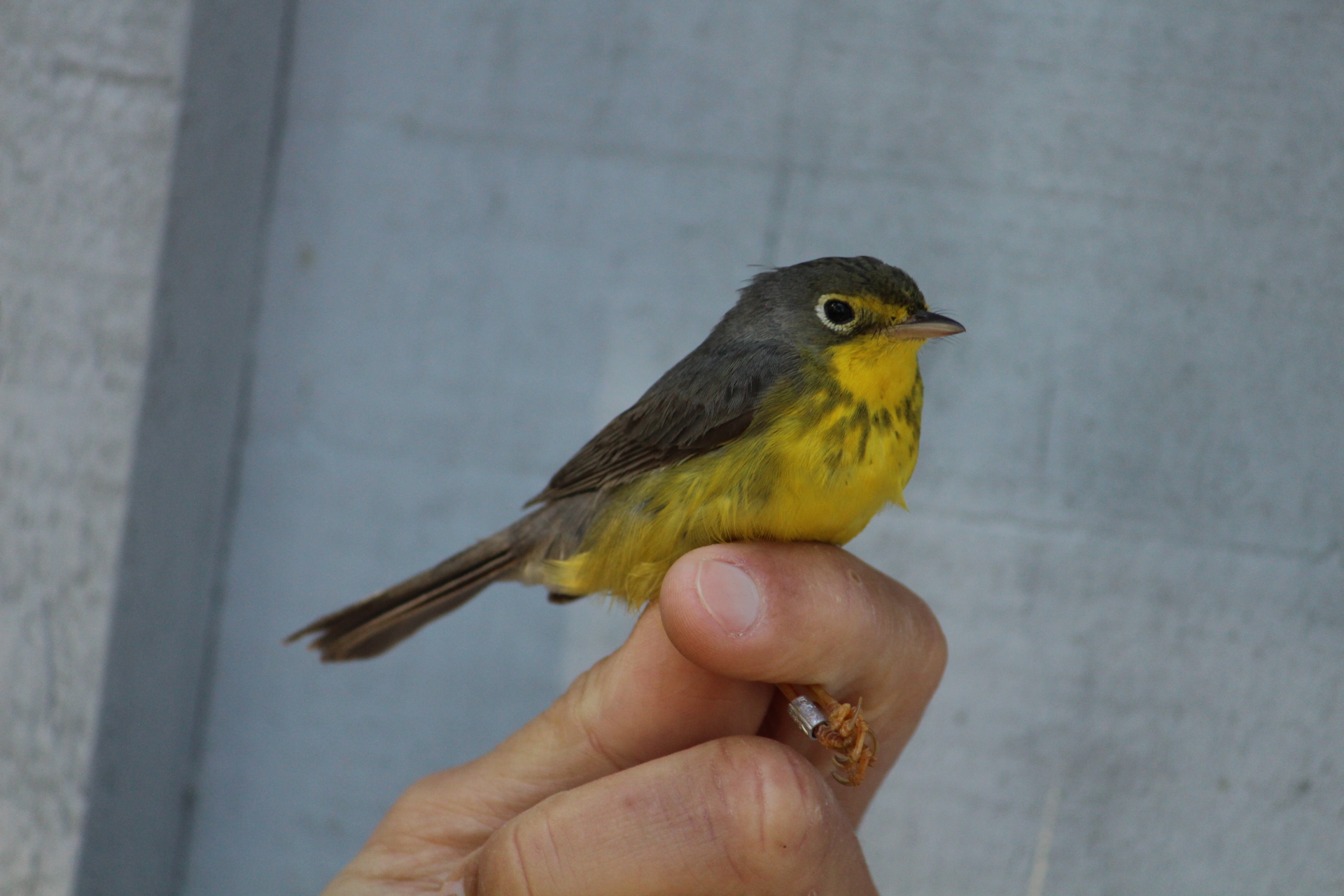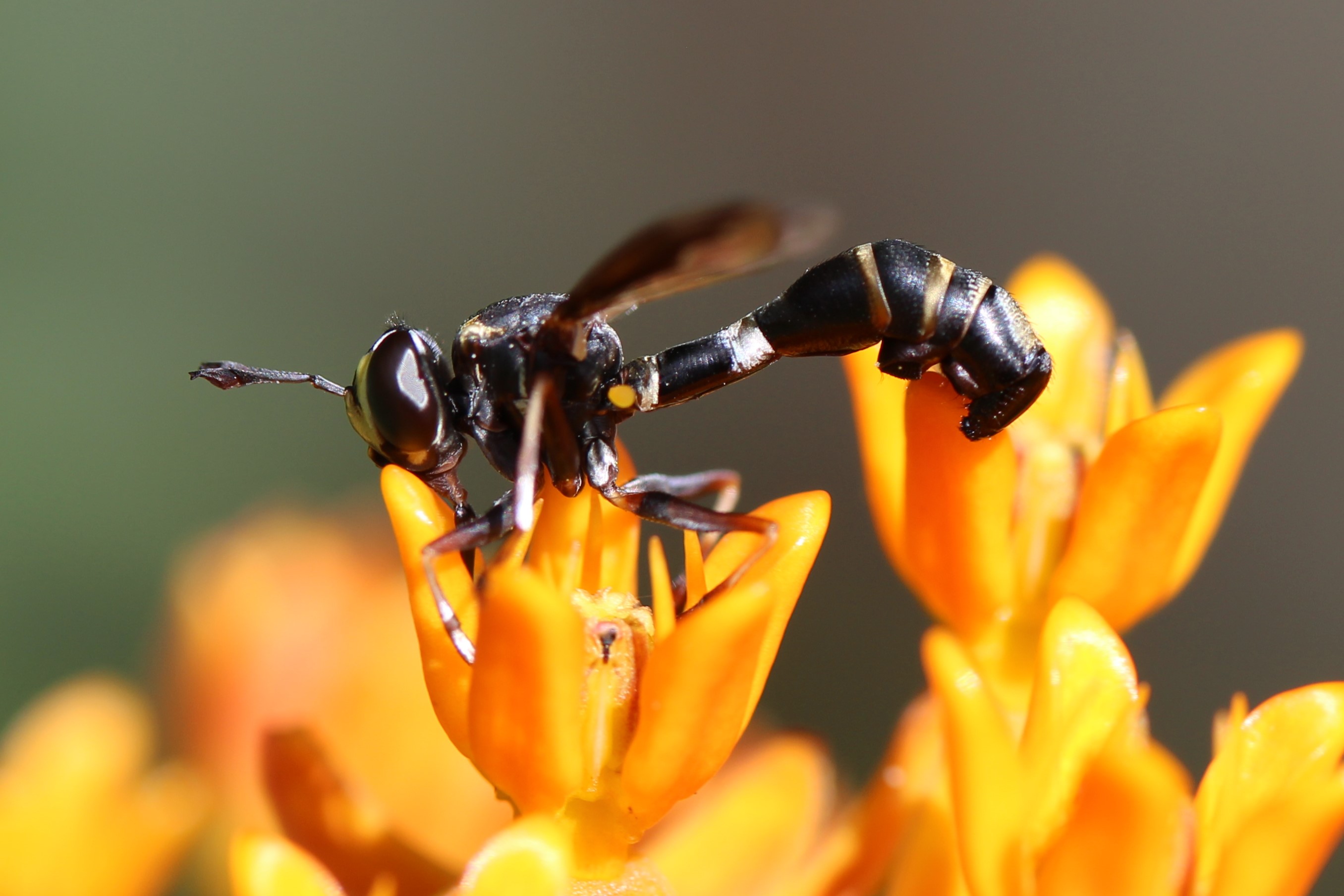
Siederia walshella, on the Lynn Valley Trail, April 2023:
On a walk on the trail by my house, I spotted this tiny creature (about a cm long) climbing up the trunk of a tree. I’m not positive on the identification, but it’s based on iNaturalist’s auto-ID for my photo and seems to match from what I can tell. If the ID is correct, this tiny caterpillar was likely searching for lichen to eat.

Eastern Spotted Newt (Notophthalmus viridescens), in my Parents’ pond, April 2023:
For the past few years, my parents’ garden pond has been host to these amazing creatures. All amphibians impress with their transformation from aquatic to terrestrial life but the Eastern Spotted Newt outdoes this life cycle with some incredible twists and turns. Larval newts transform into terrestrial juveniles (known as “efts”) and leave the water behind, living in the leaf litter. While on land, the efts have a rough reddish brown skin which keeps moisture in. After two to seven years, the efts undergo another transformation, darkening in colour and gaining a raised tail fin which aids them as they return to the water as aquatic adults. The newt pictured above is in this final stage of life: an aquatic adult. This isn’t necessarily the end of the newt’s transformations however, since some newt adults leave the water and regain some of their terrestrial attributes (rougher dry skin, loss of tail fin) for hibernation on dry land (Harding and Mifsud 2017).

Greater Bee Fly (Bombylius sp.), Lynn Valley Trail, April 2023:
This fuzzy fly has special adaptations to gather sand in its abdomen which it coats its eggs with before launching the eggs into solitary wasp nests (dug in sand presumably) (Marshall 2012). The larvae hatch from the eggs and enter the nest chambers of their host before feeding on a single host larva each (making the Bee Flies parasitoids, consumers of a single prey item).

Canada Goose (Branta canadensis) Parent and Gosling, Grant Andersen Park, May 2023:
Canada Geese are both common and abundant so they usually don’t catch my eye, but I really liked how the gosling was in the exact same pose as its nearby parent in this photo.

Spotted Sandpiper (Actitis macularius), Grant Andersen Park, May 2023:
The picture is blurry because the action was taking place across some water from my camera lens, but this fascinating courtship display was happening right in the middle of Simcoe in Grant Andersen Park. These shorebirds performed their display a few times and then mated and dispersed.

Sandhill Crane (Grus canadensis) family, Long Point, May 2023:
Sandhill Cranes have captures my heart with their wild resonant calls and their impressive size. It was a special treat to watch this family of two parents and two young foraging at the edges of a marsh in Long Point.

Canada Warbler (Cardellina canadensis), Long Point Old Cut Birding Station, May 2023:
Canada Warblers migrate into Ontario to breed during May/June, creating nests near the ground on stumps or small mounds (Bezener 2016). Then in late summer/early Fall they set off again to leave the Canadian winter behind them. Like other Wood-Warblers (the Family Parulidae) they consume insects and spiders, taken from plants or the ground.

White-Tailed Deer (Odocoileus virginianus), Lynn Valley Trail, June 2023:
This deer was incredibly close to the trail, so I was able to capture its gaze among the purple wildflowers.

Velvet Ant (Timulla vagans), Backyard, July 2023:
Velvet Ants are not members of the ant superfamily (Formicoidea) but are instead solitary wasps (members of the family Mutillidae). Their larvae develop as parasitoids on the larvae of other wasps (in the case of Timulla vagans, their hosts are Crabronids and Eumenine wasps (Marshall 2023)). The males of Timulla vagans are winged unlike the ant-like females and will carry the wingless females in their mandibles during their mating flight (Waldren et al 2020).

Physocephala marginata, Backyard, July 2023:
Although this insect drinking nectar appears to be a wasp, it is actually a fly of the Family Conopidae. Female Physocephala marginata seek out their lookalikes (wasps and bees) at flowers. After apprehending a host wasp or bee, P. marginata uses its abdomen to insert an egg inside the host’s abdomen (Marshall 2012). The egg hatches inside and the larval Conopid consumes the host from the inside.

Tachinid Fly (Exorista sp.), Backyard, August 2023:
Tachinid Flies are yet another group of parasitoid insects. Stephen Marshall, in his giant book on flies had this to say about this huge family of flies: “The Tachinidae is in many ways the ultimate fly family. With almost 10,000 named species and thousands more awaiting description… exhibits an unparalleled variety of sizes, shapes and colors. The range of life history strategies is equally amazing, at least within the constraint that every know species in the group is a parasitoid that develops inside another insect… or related arthropod” (Marshall 2012, p 386). Hosts of this genus are caterpillars or sawfly larvae.

Brown Marmorated Stink Bug (Halyomorpha halys), Backyard, August 2023:
This species of Stink Bug is native to East Asia but was introduced to North America accidentally in the 1990s. As with many successful and widespread introduced species, the Brown Marmorated Stink Bug can feed on a wide diversity of plants and can be a serious pest of agriculture and gardens. The pictured insect is a nymph, not quite an adult because it is missing fully developed wings across its back.

Green Heron (Butorides virescens), Waterford Ponds, August 2023:
The above photo was actually taken by my wife on an outing to Waterford Ponds. She was quicker on the draw to find and focus on this beautiful bird amidst the morning mist and tangled reeds of its marshy habitat. I’ve written an article about these amazing birds because of a different close encounter I had, go here to learn more!

Common Whitetail Dragonfly (Plathemis lydia), Front of House, September 2023:
As I was entering my house, I was stopped by the sight of this wondrous insect framed perfectly on my siding beside my door. I carefully entered the house to retrieve my camera in order to get this picture. One of the first Dragonflies photographed at my house since I don’t have a backyard pond… yet. The Common Whitetail pictured is a male, distinguishable because it has the chalky white abdomen which it uses as a signal to chase other males off of its territory. Females of this species have multiple bands on their wings and a dark abdomen.

Double-crested Cormorant (Nannopterum auritum), Lynn River, September 2023:
When swimming in the water, a cormorant reminds me of a hook-billed loon or a merganser, but their especially long neck gives them away. Like loons and mergansers, cormorants are underwater divers, pursuing fish prey amid lakes and rivers. This one was foraging in the Lynn River right in the middle of Simcoe, and I was very excited to get a close look at its sleek profile as it dried off on the bank. You can’t see them in the photo, but it was amidst a crowd of Canada Geese.

Great Spangled Fritillary (Argynnis cybele), Backyard, September 2023:
I at first thought this large butterfly was a Monarch (Danaus plexippus) as it was nectaring among our milkweed patch, but I quickly realized it was a different species. After patrolling our garden, this fluttering visitor rested and spread its wings on our orange plastic picnic table where I snapped this picture. The caterpillars of this species make it through our winter, after hatching just before the cold arrives (Hall et al 2014).

Black Swallowtail Caterpillar (Papilio polyxenes), Backyard, September 2023:
These colourful caterpillars feed on plants in the Carrot family (Apiaceae), and there were several munching away on our garden carrots this year. My 3-year old son helped me demonstrate one of their defensive strategies for this photo. If provoked these conspicuous caterpillars unfold the orange organ featured here, named an osmeterium, which has a foul odor (I would describe it as old rotten cheese, it was surprisingly powerful for such a small creature) (Marshall 2006). If I were a caterpillar-foraging bird or mammal, I would avoid such smelly prey.

Virginia Giant Hover Fly (Milesia virginiensis), Backus Woods, September 2023:
As the name implies, this fly was large and conspicuous in a sunny clearing. The larvae of these large flower flies (Syrphidae) develop inside rotting trees, sometimes inside tree holes (Skevington and Locke 2019).

Shadow Darner (Aeshna umbrosa), Backus Woods, September 2023:
Darners are huge dragonflies (over 7 cm long), instantly noticeable when in flight but this one cooperated in staying still while I took its picture. The Shadow Darner is named after its habit of flying late in the day (even at dusk) and staying mostly in shade (Marshall 2006). This one was photographed in the afternoon.

Chinese Mantis (Tenodera sinensis), Backyard, September 2023:
There are no Mantids native to Ontario, both of our common species: the European Mantis (Mantis religiosa) and the Chinese Mantis pictured here, were introduced to North America over a hundred years ago (Marshall 2006). This very large and impressive insect was clambering through my garden and nicely posed for a few pictures but this was my favourite photo I took, showcasing its powerful grasping forelegs and its triangular head.
References:
Bezener, Andy. 2016. Birds of Ontario. Partners and Lone Pine Publishing.
Hall, Peter, Jones, Colin, Guidotti, Antonia, and Hubley, Brad. 2014. The ROM Field Guide to Butterflies of Ontario. Royal Ontario Museum.
Harding, James H. and Mifsud, David A. 2017. Amphibians and Reptiles of the Great Lakes Region. University of Michigan Press.
Marshall, Stephen. 2006. Insects: Their Natural History and Diversity. Firefly Books.
Marshall, Stephen. 2012. Flies: Their Natural History and Diversity. Firefly Books.
Marshall, Stephen. 2023. Hymenoptera: The Natural History and Diversity of Wasps, Bees, and Ants. Firefly Books.
Skevington, Jeffrey H. and Locke, Michelle M. 2019. Field Guide to the Flower Flies of Northeastern North America. Princeton University Press.
Waldren GC, Roberts JD, Pitts JP (2020) Phoretic copulation in the velvet ant Sphaeropthalma pensylvanica (Lepeletier) (Hymenoptera, Mutillidae): A novel behavior for Sphaeropthalminae with a synthesis of mating strategies in Mutillidae. Journal of Hymenoptera Research 78: 69-89. https://doi.org/10.3897/jhr.78.55762
For last year’s photo recap, see: Norfolk Naturalist Year in Photos (Dec 2021-Nov 2022)


















